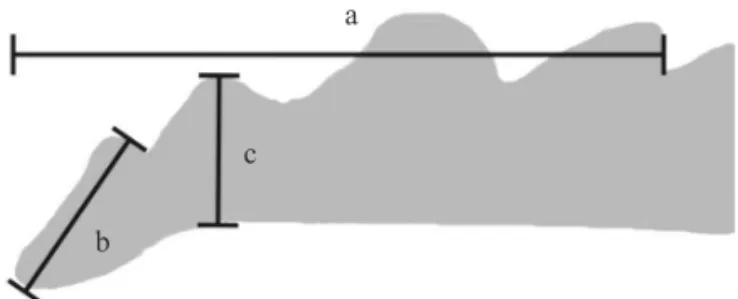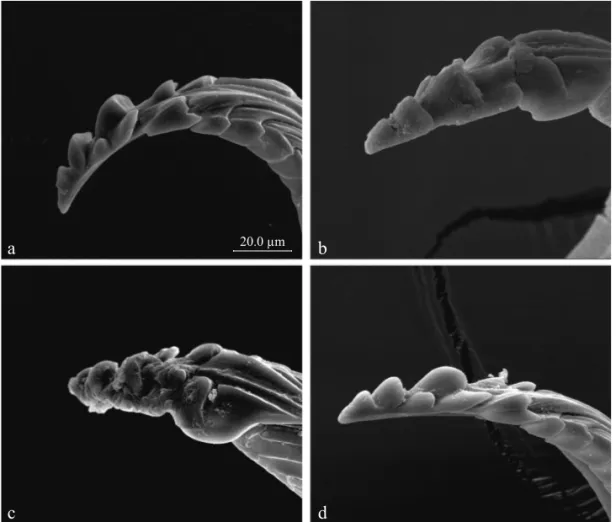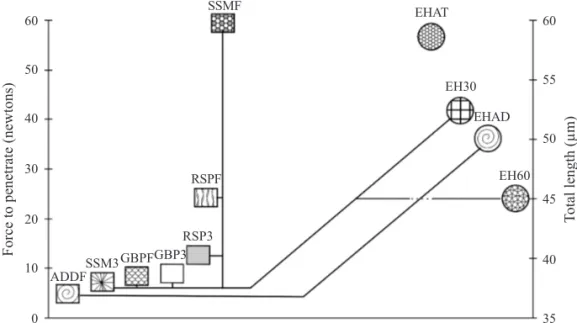SYSTEMATICS, MORPHOLOGY AND PHYSIOLOGY
Aging and Food Source Effects on Mandibular Stylets Teeth Wear of
Phytophagous Stink Bug (Heteroptera: Pentatomidae)
ROGÉRIO A DEPIERI
1, FÁBIO SIQUEIRA
1, ANTÔNIO R PANIZZI
21Univ Federal do Paraná, Depto de Zoologia, CP 19020, Curitiba 81531-990, PR, Brazil
2Embrapa Soja, Lab de Entomologia, CP 231, Londrina 86001-970, PR, Brazil; panizzi@cnpso.embrapa.br
Edited by Roberto A Zucchi – ESALQ/USP Neotropical Entomology 39(6):952-956 (2010)
ABSTRACT - Studies were conducted to test the effect of age and food sources on wear of the mandibular teeth of the phytophagous pentatomid, Euschistus heros (F.). The total length (μm) of the area bearing the mandibular teeth, the length of the 1st tooth, and the height of the 2nd tooth for teneral (< 1 day-old) adults were signifi cantly greater than that of adults fed on natural [green bean, Phaseolus vulgaris pods, raw shelled peanuts, Arachis hypogaea, and mature soybean, Glycine max seeds] for 30 or 60 days. Adults fed on artifi cial dry diet showed, in general, similar results to those of teneral adults. Force (Newtons) required penetrating the natural foods was signifi cantly greater than that required penetrating the artifi cial diet. The greater hardness of the natural foods caused increased mandibular serration wear.
KEY WORDS: Euschistus heros, mouthpart, morphology, penetration resistance, diet
Insect feeding on tough plant parts often results in considerable wear of mandibles (Chapman 1995). Despite their highly sclerotized nature, which can be increased with the addition of zinc or manganese to the cuticle (Schofi eld et al 2002), this phenomenon does occur.
Variable degrees of wear to the mandibles have been recorded in several insect groups with chewing mouthparts, such as grasshoppers (Chapman 1964, Gangwere 1965, Gangwere et al 1976, Kaufmann 1971), caterpillars (Djamin & Pathak 1967), and beetles (both phytophagous and carnivores) (Raupp 1985, Wallin 1988). Even insects feeding on “soft” food, such as fungi, show mandibular teeth wear (Welton 1988). Damage to mandibles and other mouthparts structures is widespread amongst aquatic insect larvae that graze on algae (Arens 1990), and it is probably a widespread phenomenon in longer-lived mandibulated insects.
Regarding insects with piercing/sucking mouthparts, little is know about the effect of food and/or age on the wear of mandibular stylets. The only report found is by Roitberg et al (2005), who compared stylet wear of old and young adults of the zoophytophagous Dicyphus hesperus Knight (Heteroptera: Miridae). They found that feeding on plant tissue increased mandibular stylets wear compared to feeding on animal (softer) prey.
To date, no study was made to measure mandibular wear of phytophagous stink bugs of different ages feeding on natural and artifi cial diets. To test this, we selected females of the pentatomid Euschistus heros (F.) of known ages, and offered them different types of food sources. We wanted to test the hypothesis that aging and tougher food source will increase mandibular wear.
Material and Methods
Insect colony. Adults of E. heros were fi eld-collected using a sweep on soybean, Glycine max cultivated at Embrapa Soja, in Londrina, PR, Brazil (latitude 23º 18’ S) during October 2008. A colony was established in the laboratory. Bugs were fed on fresh green bean pods (Phaseolus vulgaris), raw shelled peanuts (Arachis hypogaea), and mature soybean seeds, which were replaced every two days. Pairs (n = 30) were placed in each of three clear plastic boxes (25 x 20 x 20 cm), and provided with the above mentioned foods. Boxes were kept in a walk-in chamber at 25 ± 1°C temperature, 65 ± 5% RH and a photoperiod of 14:10h (L:D). Food was replaced every other day and nymphs obtained were raised to adults. Cotton balls were offered as oviposition substrates (Silva & Panizzi 2007).
fi xatives residues. Post-fi xation was made on 1% sodium phosphate-buffered osmium tetroxide for 1h.
After dehydration in an increased serial of ethyl alcohol concentrations, the samples were glued on carbon tape stick on specimen stub. The dried samples were gold coated with a sputter coater (BAL-TEC SCD050®, Balzers,
Liechtenstein), and examined and photographed using a scanning electron microscope (FEI Quanta 200®, Eindhoven,
The Netherlands).
The mandibular teeth wear was evaluated by the measurement of the total length of the area bearing the mandibular teeth (m) (Fig 1a), length of distal (1st) tooth (m) (Fig 1b), and height of the 2nd tooth (m) (Fig 1c). The reason why measurement of “a” was taken is because this is the most important structure cutting the food source; “b” and “c” measurements were taken because the wear of the distal teeth is more pronounced on its length, and the wear of the 2nd tooth is more pronounced on its height, respectively.
Food resistance to stylet penetration. A penetrometer (Marconi MA933, 0.25 mm/s, 3 mm diameter pin, Piracicaba, SP, Brazil) was used to determine the force required to penetrate the different natural diets, and the dry artifi cial diet piece used. The pin of the penetrometer used had a 3 mm diameter, with a sharp tip. The mean penetration time used for each diet was 8 s for soybean seed (n = 22), 12 s
for raw shelled peanut (n = 22), and 14 s for green bean pod (n = 22) and for artifi cial diet (n = 35). Results of the force needed to penetrate the diets are expressed in Newtons (unit of force derived in the SI system equal to the amount of force required to accelerate a mass of one kilogram at a rate of one meter/s2), which were calculated multiplying the
kg/f (the penetrometer output unit) by 9.806, this last value the gravity force.
Data analyses. Means of the different measurements taken of the mandibular tip, and means of the force required to penetrate the different food sources were analyzed with analysis of variance (ANOVA). They were compared using the Tukey test for multiple means (P < 0.05) comparison, which was performed using the program SAS version 8.2 (SAS Institute 1981, Zar 1984).
Results and Discussion
Mandibular wear in adult Euschistus heros. The mandibular
wear of female E. heros adultswas variable according to the insect age and food source used (Table 1). Considering the total length of the area bearing the mandibular teeth, teneral (< 1 day-old) adults showed signifi cantly (P < 0.05) greater values (= no wear) compared to those fed for 60 days either on natural or artifi cial diets. Younger (30 days) adults showed an intermediate length value, i.e., tendency of more wear of the serrated mandibular stylet compared to teneral adults, but less wear compared to adults fed for 60 days on the natural or on the artifi cial diets. Although these differences were not signifi cant, there was a clear tendency of shortening of the serrated area as the bugs fed for longer periods on the natural diet (Table 1).
The length of the distal (1st) tooth followed a similar pattern. Teneral adults (Fig 2a) showed signifi cantly longer length (= no wear) than adults fed on the natural diet, either for 30 (Fig 2b) or 60 (Fig 2c) days, while those fed on the artifi cial diet did not show any shortening (wear) of the 1st tooth (Fig 2d). Considering the height of the 2ndtooth, teneral adults showed the greatest value (= no wear), while those Fig 1 Schematic drawing of the mandibular tip of adult
female Euschistus heros; a) total length of the area with teeth; b) length of the most distal teeth (1st tooth); c) height of the 2nd tooth (1,200x).
Table 1 Mandibular wear indult Euschistus heros females of different ages feeding on natural and on artifi cial diet (n = number of individuals examined). See Fig. 1 for details illustrating how the measurements of the items below were taken.
Means followed by the same letter in the columns do not differ signifi cantly using the Tukey test (P ≤ 0.05). a
c
b
Adult age (food) Total length of area bearing the mandibular teeth (μm)
Length of the distal (1st) tooth (μm)
Height of the 2nd tooth (μm)
Teneral (< 1 day-old)
57.9 ± 2.52 a (5)
14.1 ± 0.29 a (5)
14.2 ± 0.52 a (5) 30 days
(natural diet)
52.2 ± 1.63 ab (5)
11.7 ± 0.29 b (5)
11.1 ± 0.34 b (5)
60 days (natural diet)
45.0 ± 1.84 b (5)
9.9 ± 0.23 c (5)
9.7 ± 0.62 b (4) 60 days
(artificial diet)
50.0 ± 1.11 b (4)
13.4 ± 0.37 a (4)
fed either on natural (30 or 60 days) or on the artifi cial diet had similar smaller values (Table 1).
These results clearly demonstrate wear of the tip of the mandibular stylet of E. heros as a result of aging and feeding on different food sources. Roitberg et al (2005) working with the zoophytophagous mirid Dicyphus hesperus Knight found that older females had greater mandibular teeth wear than younger ones. Moreover, they reported that mandible stylets wear was increased when bugs fed on plants, compared to those offered water only; this wear is caused by the resistance of tissue penetration imposed to the stylets (see below).
Resistance of food to stylet penetration. Results to measure the force required penetrating the natural and the artifi cial diets are shown in Table 2. Data demonstrate that natural foods either fresh or after three days of exposition to the bugs were harder to penetrate than the artifi cial diet.
The relationship between forces needed to penetrate the different foods and the total length of the mandibular tip bearing serration is illustrated in Fig 3. The natural foods showed variable resistance to be penetrated, with higher values for soybean seed mature fresh (SSMF) and raw shelled peanut fresh (RSPF). After three days of exposure to the bugs, their resistance to penetration decreased and were similar to those of green bean either fresh (GBPF) or after three days of use (GBP3), as they got softer by acquiring humidity. These natural foods used by E. heros females for 30 (EH30)
Fig 2 Scanning electron microscopy (1,200x) of the mandibular tip of adult female Euschistus heros; a) teneral (< 1 day-old) adults; b) 30 day-old adult fed on natural diets; c) 60 day-old adult fed on natural diets; and d) 60 day-old adult fed on artifi cial diet.
Table 2Mean (± SE) value of force required to penetrate the natural and the artifi cial diets offered to adult females Euschistus heros in the laboratory.
Mean values followed by the same letter do not differ signifi cantly using the Tukeytest (P ≤ 0.05). Data transformed √x for analysis.
a 20.0 μm b
c d
Diets Force to penetrate
(newtons)
Soybean seed mature (fresh) 59.4 ± 1.73 a (22)
Raw shelled peanut(fresh) 24.5 ± 0.61 b (22)
Raw shelled peanut(after three days)
11.2 ± 0.51 c (22)
Green bean pod (after three days) 9.3 ± 0.57 cd (22)
Green bean pod (fresh) 9.2 ± 0.38 cd (22)
Soybean seed (after three days) 8.5 ± 0.40 d (22)
or 60 (EH60) days resulted in decrease of the total length of the mandibular tip. An intermediate value in mandibular length is observed for those bugs fed on the dry artifi cial diet (EHAD) which force needed to penetrate the diet (ADDF) was the least. Finally, E. heros adult teneral (EHAT) that did not feed, showed the longest mandibular tip serration.
Mandibular serration in Heteroptera have been discussed and illustrated by several authors (Faucheux 1975, Cobben 1978, Cohen 1990, 1996) but, except for the paper of Roitberg et al (2005), no information was found in the literature regarding the effect of aging and food use on mandibular serration wear. Apparently, mandibular wear do not prevent bugs from feeding, but this might have some infl uence on the feeding frequency of old adults. However, at this point this can only be speculated and clearly, additional studies should be carried on this issue to demonstrate if mandibular serration wear has or not any effect to these sucking insects feeding activity.
In conclusion, our results demonstrate that aging and tougher food source does increase mandibular stylet serration wear of the neotropical brown stink bug, E. heros as hypothesized.
Acknowledgments
We thank Allen C Cohen for critically reading the manuscript. This research was supported by a scholarship to R A Depieri from the Conselho Nacional de Desenvolvimento Científi co e Tecnológico (CNPq), and through laboratory facilities provided by Embrapa Soja, and Universidade Estadual de Londrina, PR. This paper was approved for publication by the Editorial Board of Embrapa Soja as manuscript number 17/2009.
References
Arens W (1990) Wear and tear of mouthparts: a critical problem in stream animals feeding on epilithic algae. Can J Zool 68: 1896-1914.
Chapman R F (1964) The structure and wear of mandibles in some African grasshoppers. Proc Zool Soc London 143: 305-320.
Chapman R F (1995) Mechanics of food handling by chewing insects, p. 3-31. In Chapman R F, Boer G (eds) Regulatory mechanisms in insect feeding. New York, Chapman & Hall, 398p.
Cobben R H (1978) Evolutionary trend in Heteroptera. Part II. Mouthpart-structures and feeding strategies. Med Landbouwhogesch, Wageningen 78-5, 407p.
Cohen A C (1990) Feeding adaptations of some predaceous Hemiptera. Ann Entomol Soc Am 83: 1215-1223.
Cohen A C (1996) Plant feedingby predatory Heteroptera: evolutionary and adaptational aspects of trophic switching, p. 1-17. In Alomar O, Wiedenmann R N (eds) Zoophytophagous Heteroptera: Implications for life history and integrated pest management. Lanham, Proc Thomas Say Publications in Entomology, 202p.
Djamin A, Pathak M D (1967) Role of silica in resistance to Asian rice borer, Chilo suppressallis (Walker), in rice varieties. J Econ Entomol 60: 347-351.
Faucheux M M (1975) Relations entre l’ultrastructure des stylets mandibulaires et maxillaires et la prise de nourriture chez les insectes hemipteres. C R Acad Sci Paris (Ser D) 281: 41-44.
Gangwere S K (1965) Food selection in the oedipodine grasshopper Arphia sulphurea (Fabricius). Am Midl Nat 74: 67-75. Fig 3 Relationship between forces needed to penetrate the different natural and artifi cial diets used to feed adult female
Euschistus heros and the total length of the mandibular tip bearing serration. ADDF = artifi cial dry diet fresh; SSM3 = soybean seed mature after three days of use; GBPF = green bean pod fresh; GBP3 = green bean pod after three days; RSP3 = raw shelled peanuts after three days; RSPF = raw shelled peanuts fresh; SSMF = soybean seed mature fresh; EHAT = E. heros adult teneral; EH30 = E. heros fed 30 days on natural food; EHAD = E. heros fed artifi cial diet (60 days); and EH60 = E. heros fed 60 days on natural food (see text for explanation).
Force to penetrate (newtons)
T
otal length (
μ
m)
ADDF
SSM3 GBPFGBP3 RSP3
RSPF
SSMF EHAT
60 60
55 50
50 40
45 30
40 20
10
35 0
EH30
EHAD
Gangwere S K, Evans F F, Nelson M L (1976) The food-habits and biology of Acrididae in an old-fi eld community in southeastern Michigan. Great Lakes Entomol 9: 83-123.
Kaufmann T (1971) Biology and ecology of Melanoplus borealis (Orthoptera: Acrididae) in Fairbanks, Alaska with special reference to feeding habits. Michigan Entomol 4: 3-13.
Panizzi A R, Parra J R P, Santos C H, Carvalho D R (2000)Rearing the southern green stink bug using an artifi cial dry diet and an artifi cial plant. Pesq Agropec Bras 35: 1709-1715.
Raupp M J (1985) Effects of leaf toughness on mandibular wear of the leaf beetle, Plagiodera versicolora. Ecol Entomol 10: 73-79.
Roitberg B D, Gillespie D R, Quiring D M J, Alma C R, Jenner W H, Perry J, Peterson J H, Salomon M, VanLaerhoven S (2005) The cost of being an omnivore: mandible wear from plant feeding in a true bug. Naturwissenschaften 92: 431-434.
SAS Institute (1981) SAS for linear models. A guide to the ANOVA and GLM procedures. SAS Institute, Cary, N.C.
Schofi eld R M S, Nesson M H, Richardson K A (2002) Tooth hardness increases with zinc-content in mandibles of young adult leaf-cutter ants. Naturwissenschaften 89: 579-583.
Silva F A C, Panizzi A R (2007). Cotton balls as an oviposition substrate for laboratory rearing of phytophagous stink bugs (Heteroptera: Pentatomidae). Ann Entomol Soc Am 100: 745-748.
Wallin H (1988) Mandible wear in the carabid beetle Pterostichus melanarius in relation to diet and burrowing behaviour. Entomol Exp Appl 48: 43-50.
Welton M N (1988) A morphometric analysis of mandibular teeth in Falsomia (Collembola: Isotomidae). Zool J Linn Soc 94: 99-109.
Zar J H (1984)Biostatistical analysis. 2nd ed., Prentice-Hall, Englewood Cliffs, N.J.


